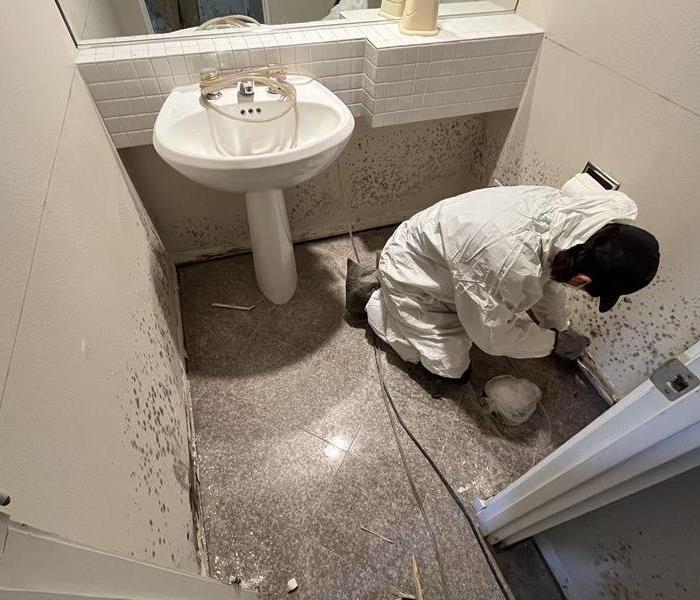Archived Mold Remediation Blog Posts
Common Mold Misconceptions
5/1/2024 (Permalink)
There are many misconceptions with mold, and I am sure you many of you have seen sensational news reports that warn about the dangers of “black mold” or “toxic mold”. These reports can be alarming and confusing so it’s beneficial to get the facts to better understand mold.
When water intrudes into your property, mold growth can start in as little as 48 hours. There are many types of mold, and many of them can produce allergens and irritants, causing a reaction to those exposed to it. It is important to note that in many instances multiple types of mold may exist in the same house or structure. So, no matter the look or type of the mold it is that you see, you never know how far it has spread in the unseen parts of your property and if it is the same mold.
Here are some additional facts to better understand mold;
- Mold is present almost everywhere, indoors and outdoors.
- Mold spores are microscopic, float along in the air, and may enter your home through windows, doors, or AC/heating systems or even hitch a ride indoors on your clothing or a pet.
- Mold spores thrive on moisture. Mold spores can quickly grow into colonies when exposed to water. These colonies may produce allergens and irritants.
- Before mold remediation can begin, any sources of water or moisture must be addressed. Otherwise the mold may return.
- Mold often produces a strong, musty odor, and that odor can lead you to possible mold problem areas.
- Even higher-than-normal indoor humidity can support mold growth. Keep indoor humidity below 45 percent.
If you find mold in your home it is important to stay out of the affected area, to not disturb it (this includes cleaning) and to immediately call 760-SERVPRO. We will be able to properly assist the situation and make the best plan to effectively remedy the mold within your property.
Understanding Mold Remediation Services: Find the Source to Make Your Home or Business Comfortable
6/4/2023 (Permalink)
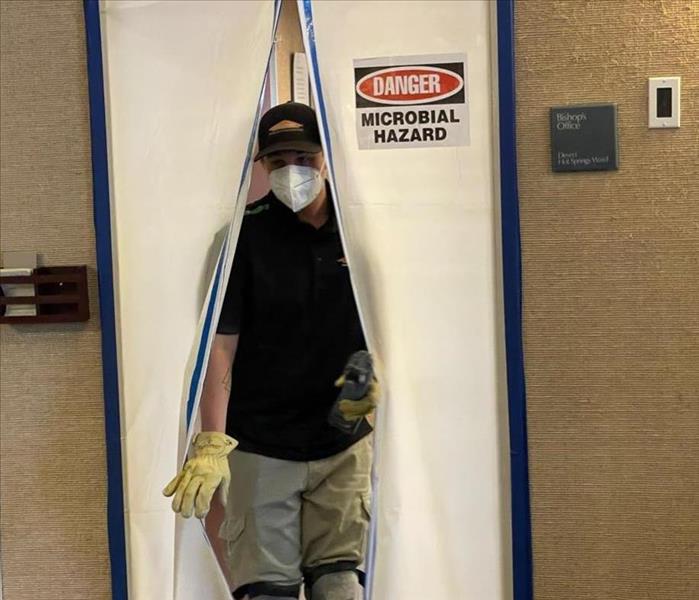 One of our expert remediation technicians quarantining a room that has a severe mold outbreak.
One of our expert remediation technicians quarantining a room that has a severe mold outbreak.
When it comes to dealing with mold in your home, it's essential to differentiate between mold removal and mold remediation. Mold removal involves physically eliminating mold spores, while mold remediation focuses on restoring mold levels to normal, natural levels. Nowadays, many mold remediation companies claim to remove all mold from your home, but that's simply not possible. Mold spores are ubiquitous, making 100% mold removal an unrealistic goal, regardless of your location. Mold remediation and mold removal are often used interchangeably in the industry. However, complete mold removal is unattainable due to the microscopic nature of airborne mold spores, which can be found both indoors and outdoors.
Signs of Mold in Your Home
Mold that is not visible to the naked eye can go unnoticed until you start experiencing mold-related symptoms such as coughing, watery eyes, a runny nose, or sudden congestion. If these symptoms disappear when you leave your home, it's likely that indoor mold is the culprit. This becomes a concern because certain molds can be toxic to both humans and pets. Severe cases of mold infestation can lead to life-threatening illnesses, severe asthma attacks, and even neurological problems.
Musty odors inside your property can indicate the presence of certain molds, but not all molds produce noticeable smells. We recommend conducting a visual inspection and an air sample test to identify mold growth and determine the type of mold present.
Long-term water damage is a major cause of mold growth. Mold spores can attach themselves to surfaces within 48 hours of water exposure. Water damage can occur due to small plumbing leaks or areas that have been exposed to water for extended periods.
Understanding Mold
Mold is a natural part of the environment, and it can proliferate rapidly indoors when mold spores land on wet surfaces. When water intrudes into your property, mold growth can begin within as little as two days, causing significant damage to both your home and your health. Consider the following facts about mold:
- Mold exists indoors and outdoors.
- Mold spores thrive in moist environments.
- When exposed to water, mold spores can quickly form colonies.
- Not all mold is visible; an air test may be necessary if you suspect mold.
- Mold often produces a strong musty odor.
- Exposure to certain types of mold can have severe health consequences.
While these measures may not eliminate existing mold, controlling moisture can inhibit further mold growth. It's important to consider long-term treatment and management solutions.
The Process of Mold Removal and Remediation
Since complete mold removal is not possible, the key to "removing" mold is to control its growth. Here are six steps to follow:
Step 1: Contact a local certified mold remediation professional
Reach out to a certified mold remediation professional in your area who can assess the severity of your mold issue. They will ask you questions to determine the necessary equipment and resources needed to address the problem effectively. Acting quickly when you spot mold can save you time and prevent further property damage and health issues.
Step 2: Mold Inspection and Mold Damage Assessment
If you notice visible signs of mold, there may be no need for a mold air test. A certified mold remediation company can inspect your home thoroughly, identify the type of mold and its source. It is advisable to work with a company that offers both mold remediation and leak detection services if the source of the mold has not been detected.
Step 3: Mold Containment
As mentioned earlier, mold spores are naturally abundant in the atmosphere. However, mold becomes a significant concern when it finds a damp environment and organic materials to thrive on inside your home. Prolonged moisture and an organic food source provide ideal conditions for mold growth.
When it comes to containing mold, remediation companies play a crucial role in finding solutions to keep the issue under control. They address the source of the problem, such as leaks, standing water, or ventilation issues, to prevent further mold growth. By repairing these underlying issues, they create an environment that is unfavorable for mold development.
The second aspect of mold containment is preventing its spread to other areas of the home. A professional mold remediation company will establish barriers and employ negative air pressure techniques during the cleanup process. These measures ensure that mold spores are confined and do not disperse to unaffected areas.
Step 4: Mold Removal and Mold Remediation
Mold remediation goes beyond removal and includes the proper disposal of mold-infested porous materials such as drywall and carpeting. These steps are necessary to address severe mold growth within a home.
It is crucial to choose a mold remediation company that holds a general contractor's license. This is particularly important because mold remediation often involves opening up walls, subfloors, and working with the building's frame. These actions are necessary when dealing with non-visible mold growth within walls or foundations. If a mold remediation company lacks a general contractor's license, it could indicate that they are either operating without a license or subcontracting the work to another company. To ensure transparency and quality service, it is advisable to inquire whether a mold remediation company is licensed as a contractor and if they subcontract any work, especially for extensive mold problems within your home.
If you suspect or detect mold in your home and are unsure of how to proceed, SERVPRO of Palm Desert offers comprehensive mold remediation services for homes and businesses of all sizes. Don't wait for your mold problem to escalate. Take proactive steps to address it promptly and effectively.
SERVPRO specializes in Mold Remediation and Restoration in the Palm Desert area.
8/23/2021 (Permalink)
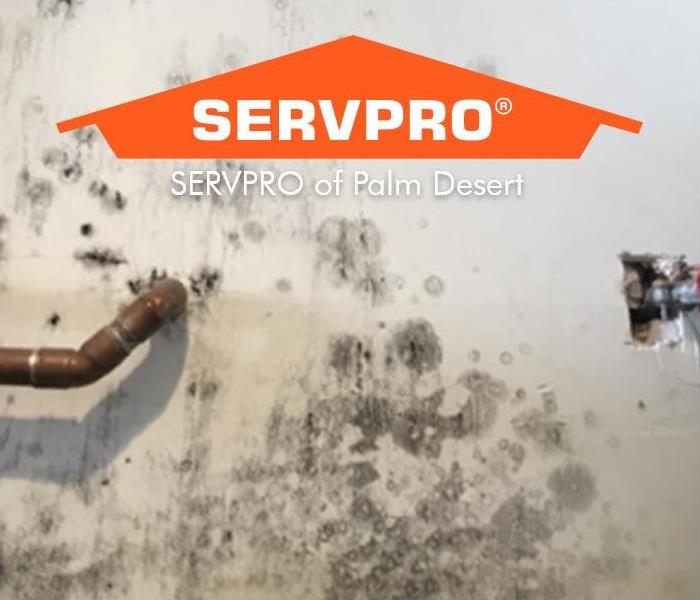 Call SERVPRO of Palm Desert before mold takes over your home or business!
Call SERVPRO of Palm Desert before mold takes over your home or business!
Mold does not need much to start forming in your home or business. Mold can start forming due to a little water leak from a pipe or some humidity build up in a bathroom. Once that mold starts forming it can spread as quickly as 48 hours!
Here at SERVPRO of Palm Desert, we pride ourselves on how fast we get to the bottom of your mold issue and restore the area "Like it never even happened."
Mold is a very serious thing to deal with because it has the potential to produce allergens, irritants, and other health effects. SERVPRO of Palm Desert will inspect and assess your property before remediating your mold problem. Our SERVPRO technicians have undergone specialized training to ensure the job is done right and quickly!
Call us right away at (760) 346-7270, if you smell a “musty” odor or see black spots. The earlier we catch the problem, the simpler it will be to fix.
Should You Buy a House with Mold Problems
6/15/2021 (Permalink)
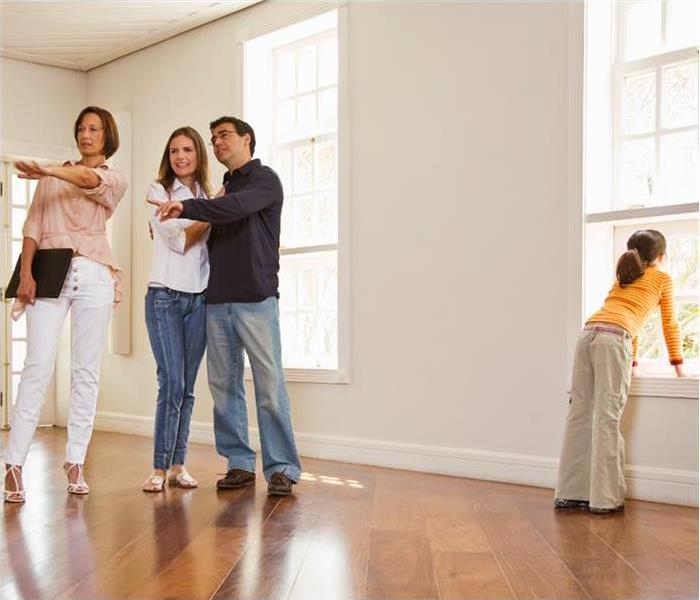 Realtor showing a Potential buyer a home without knowing if there is mold.
Realtor showing a Potential buyer a home without knowing if there is mold.
You finally find the home of your dreams after searching forever in the Palm Desert area. Just before signing on the dotted line, you discover that the home has mold problems. Should you buy your dream house anyway?
First, let’s talk about what mold is. Mold is a type of fungus that can grow anywhere if given the right conditions. Thousands of species of mold can be found in houses; from the kind that grows on bread and fruit to the mold that inhabits humid spaces. Exposure to some types of mold can even cause health effects, so you'll need to have it removed from the home as soon as possible to be safe.
Also, mold may cause serious structural damage to a building because it feeds on and breaks down organic matter. Therefore, when mold infests walls, insulation, paper backing, or carpeting, the materials must be removed.
Before you buy any home, make sure you have it inspected for mold and other problems. Insist that the inspection contains a contingency clause (which defines a condition or action that must be met for a real estate contract to become binding). Never take a seller's or real estate agent's word about the presence of mold. Even if you're getting a really good discount, you want to get an inspection. The cost of removing the mold could end up being greater than your savings. If mold is exposed during the inspection, you have a bargaining chip. You can then do one of three things:
- Ask the seller to reduce the asking price
- Ask the seller to fix the problem
- Walk away from the deal
Sellers are required under state real estate disclosure rules to disclose if there’s an ongoing mold problem in the house or if it’s been previously flooded, but they don't always do so. If they do not, the owner may be liable to you for failure to disclose. (See the Nolo article, "Home Defects: Sue the Seller," which provides useful advice on determining who’s legally responsible for home defects and how to file suit.)
You may decide to tackle the mold clean up yourself, but some mold grows deep roots that can only be removed with the right tools. This will cause the mold to keep coming back if it is not removed properly. Mold can also be very difficult to find. You would be better off using a company that specializes in mold removal like SERVPRO of Palm Desert.
There's no right answer for whether it's OK to buy a home with mold. Your primary concerns should be your budget, your health and how soon you need to move in. On the other hand, if you’ve got the time and money to get rid of the mold, purchasing a home with mold in it could save you money, especially if your home is appraised lower because of the mold.
Give SERVPRO of Palm Desert a call today and let our professionals handle the mold in your home!
Basic Facts About Mold
4/15/2020 (Permalink)
 Roof leaks can lead to hidden mold
Roof leaks can lead to hidden mold
Mold can be quite a nuisance and can be very dangerous, especially for those with respiratory issues. Not only is mold dangerous but mold grows rapidly in places where moisture resides. Our homes and workplaces are surrounded by sources of moisture.
Mold is usually found near leaky roofs, windows, pipes, and where flooding has occurred. Mold grows typically well on paper products like cardboard, on tiles and wood products, in dust, paints, wallpaper, insulation, drywall, carpets, fabric, and even upholstery. The goal is to keep mold out of the home and to know what to do if you find mold.
How does mold get indoors?
Mold enters easily through open doorways, windows, vents, and HVAC systems. Mold often comes indoors by attaching itself to clothing, shoes, and pets.
How does mold grow rapidly?
Mold will travel indoors and drop in places where there is plenty of moisture. Materials that hold moisture have enough nutrients to allow mold to thrive and grow at a rapid pace. Keeping moisture out of the home is ideal but more difficult than expected.
How do I keep mold from growing?
- Keep humidity levels down, between 30% and 50% by using an air conditioner or a dehumidifier
- Fix leaky roofs, windows, pipes.
- Ventilate shower, laundry, and cooking areas and ensure these areas have ventilation sources such as vents.
- In flooding events, clean and dry the affected area by contacting SERVPRO of Palm Desert for mold remediation and restoration.
ELIMINATE MOLD PROBLEMS
3/2/2017 (Permalink)
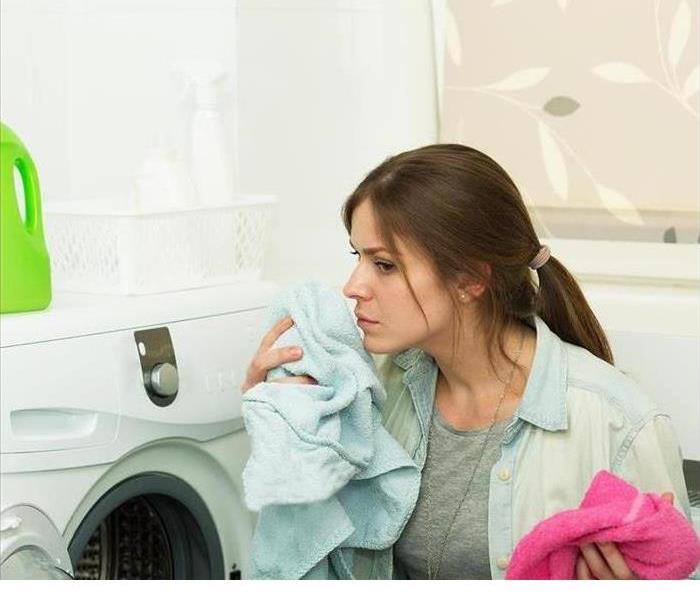 Mold Odors in the Laundry Room
Mold Odors in the Laundry Room
SERVPRO's Palm Desert Remediation Can Eliminate Mold Problems
No one wants mold damage anywhere in their home, but the laundry room is a common and frustrating area where it makes itself known. You try to remove the mold yourself without success and finally ask, "what company near me holds the key to complete mold remediation?" The answer is SERVPRO, your local mold management and remediation experts.
It is not surprising that mold damage plagues your Palm Desert laundry room. Plenty of organic material and a wide range of microbial accelerants lie in your laundry room. The area is isolated, in an out of the way corner of your home. The long term leaks on the back of your washer itself is a treasure trove of nooks and crannies that hide mold growth. You sniff the musty odor every time you open the door to the laundry room.
Dealing with persistent mold is not a do it yourself job. All your efforts fail because mold is a tricky problem that requires remediation experts from SERVPRO to conquer. Mold can hide behind cabinet areas in places you may not be able to visibly see. Hoses and other plumbing connections may be examined for leaks and evidence of mold growth.
The washer and dryer themselves are possibly a source of mold contamination. Our Mold Professionals may require a Mold Test by a 3rd party for air quality and spore count. If Hoses and seals are the problems, a referral to an appliance repair specialist makes sense. Proper Containment and Mold Remediation can move your laundry room back to fresh-smelling instead of odor-creating.
If you have concerns and detect odors or see suspect microbial growth, call our friendly staff at SERVPRO of Palm Desert (760) 346-7270 to set up a consultation.
Is Mold Lurking in your Home or in a Potential Home You Want to Buy.
5/26/2016 (Permalink)
 How Mold Affects Your Health and Your Home's Value
How Mold Affects Your Health and Your Home's Value
How Mold Affects Your Health and Your Home's Value
Mold doesn't always rack up medical bills, but it will wreak havoc when you put your home on the market.
If you think your home is mold-free, you’re probably wrong.
As a fungus, mold is in soil and spreads to new locations by releasing spores into the air. It can travel through an open window or follow you inside through the front door.
But mold only becomes dangerous when it is able to attach itself to organic material and grow and spread with the right humid conditions.
Moisture allows the mold that’s already there to grow and colonize, and reproduce and spread.
People's reactions to mold vary depending on individual predispositions to mold and the type of mold growth, from no symptoms to sore throat and itchy eyes, heightened asthma problems, skin rashes and in some cases autoimmune disease from prolonged exposure. Because medical issues can vary so greatly, it doesn't matter which type of mold may be growing or how you're feeling, all visible mold growth in your home should be removed and the source of moisture repaired to ensure growth does not occur again.
Health effects are the first reasons to rid a building of mold. The second reason is the resale value and marketability of a property. Nobody wants to purchase a seller’s mold issue.
Whether you’ve lived there for decades or you haven’t even closed on the place yet, evidence of mold can trigger dozens of questions. To avoid getting lost in the details, ask a few simple questions to help you get to the root of the cause, figure out how to fix the problem and how to move forward.
What's causing the mold to grow? It could be a leaky pipe, humid basement or a hurricane that flooded your entire first floor. The size of the problem is less important than your ability to repair the source of moisture. It’s imperative to stop further moisture intrusion, otherwise, the mold will just continue to grow and spread.
Mold growth in a basement, attic or crawl space is relatively common because residents don't see these areas often, and they can be very humid.
An understanding of how mold grows in the home and the potential for adverse health effects has changed the way people look at fungus, even if it's not causing you problems, you have to kill growing mold and reduce moisture levels to prevent its return.
Bigger disasters, such as hurricanes or a pipe burst, will likely require major remediation efforts, since surfaces exposed to moisture aren’t isolated. A flooded basement, for example, could see widespread mold growth.
Who should you talk to about it? To ensure you address any evidence of mold growth appropriately, it’s best to talk to a Professional who specializes in inspecting homes and checking for mold. SERVPRO of Palm Desert may recommend you inquire about an initial mold spore test from a Certified Hygienist to obtain a written protocol for the work to be performed.
You want to make sure that you have professionals who deal with Mold Remediation on a regular basis, as opposed to one person coming out who is a drive-by repair, handyman kind of service who doesn’t understand the scientific aspect of it.
If you haven't yet closed on a home and you find mold, it’s typically a good idea to hire your own professional to assess the situation to avoid having the wool pulled over your eyes by a desperate seller.
Some things to look out for: Phrases like “mildew” and “mold-like substance” are misleading. Mold and mildew are both fungi, and they can cause health problems. Nobody differentiates between mold and mildew – they both are just as risky as the other.
How do you get rid of it? The spectrum of mold growth removal can range from a simple at-home cleaning to a heavy-duty remediation process that requires residents leave until conditions are safe enough to inhabit the home again. For spaces that are just a little too humid, a dehumidifier that's the right size will help to keep moisture levels in the air below 50 percent, which is the threshold for many types of mold to grow.
Contrary to popular belief, bleach is not an effective remedy. It will just keep coming back, especially if it’s growing on the paper on the drywall. Sprays specifically designed to kill mold are more effective, and mold-killing primer can be used to seal the surface once the mold is removed. While simple at-home fixes and smaller remediation processes are typically resolved quickly, larger mold problems could take a few days to completely mitigate.
In the case of mold from leaks and water damage, you need to not only repair the source of water, but also remove affected surfaces, kill any fungi and treat anything you cannot remove, like a painted concrete wall in your basement, to prevent mold growth from returning.
Another way to reduce the chances of mold returning to the area is to get rid of its food source, and one option is to ditch regular drywall for fiberglass drywall. Fiberglass is not consumable; it’s not edible for mold. Fungus only eats or consumes carbon-based materials or organic materials that used to be alive.
How do you make a deal when there’s mold? Any kind of major defect can break a deal or have a big impact on negotiations when buying a home, and mold is no exception.
Mold is without question one of the most prevalent risks you can come up [against when] buying and owning a house states SERVPRO of Palm Desert.
It’s not worth risking the potential health issues, and mold will simply continue to devalue your property until the problem becomes so rampant that the home is uninhabitable. Nobody wants to purchase a seller's mold issue. Attic mold almost never affects the indoor air quality in the living space, but it sure threatens real estate deals.
Regardless of whether you’re on the buying or selling end of the transaction, be sure you understand the laws about informing a purchasing party about home defects. The law in most states, generally, is that you have to disclose all known risks, which includes evidence of mold in the home. Providing the details of a previous inspection, mold lab test results or even simply stating that stains on a wall might be mold could be considered sufficient disclosure.
Evidence of mold will change the way sellers are able to negotiate, but it’s better than being found guilty of nondisclosure. How the buyer will want to proceed varies depending on the individual and where you live.
The buyer and seller can agree upon a reduction in the sale price, leaving the buyer to make repairs.
The other option is to negotiate that the seller makes all repairs before closing or the buyer taking possession of the home. The is the best way to ensure you make it Like It Never Even Happened!.
For more information and a free estimate call SERVPRO of Palm Desert 760-346-7270.
WHAT IS MOLD?
5/12/2016 (Permalink)
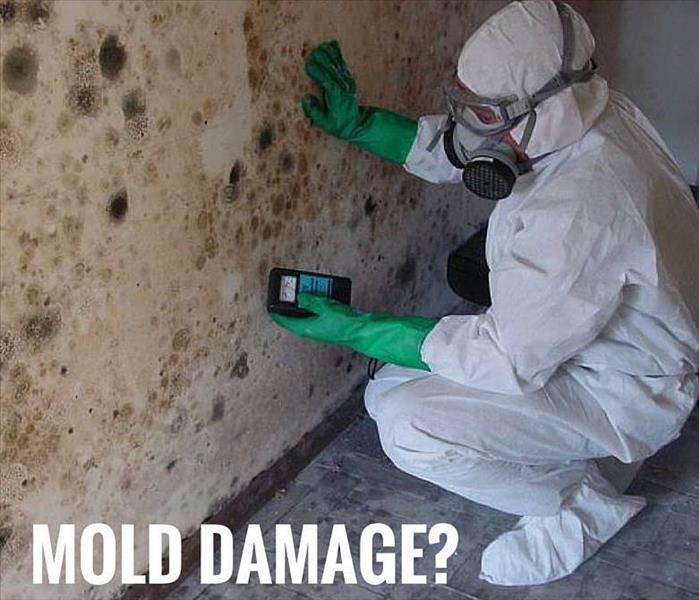 SERVPRO Mold Remediation Technician experienced and trained to take care of your home!
SERVPRO Mold Remediation Technician experienced and trained to take care of your home!
Mold is a fungus that reproduces by spreading tiny spores everywhere. Each and every day, there are millions upon millions of mold spores just drifting through the air, both indoors and outdoors. However, when mold finds moisture indoors it clings to the surface of the damp object or structure and begins increasing and digesting whatever it latches on to in order to survive. SERVPRO of Palm Desert, a home restoration company that focuses on mold damage remediation in the cities of the Coachella Valley, knows that excessive mold can be a potential threat to the health and well-being of your family. Therefore, our experienced technicians conduct mold removal and mold remediation assessments to determine if the presence of mold is a hazard.
According the U.S. Environmental Protection Agency, “Potential health effects and symptoms associated with mold exposures include allergic reactions, asthma, and other respiratory complaints.” The negative effects of mold are even greater for the elderly, young children, and those with sensitive respiratory systems. There is a lot of buzz recently amongst health enthusiasts about SBS (sick building syndrome). The U.S. Environmental Protection Agency stated that, “(SBS) is used to describe situations in which building occupants experience acute health and comfort effects that appear to be linked to time spent in a building.” SBS is alarming because homeowners complain of symptoms like unexplainable fatigue, nauseating headaches, eye, nose, or throat irritation, dry cough, dizziness and nausea, and sensitivity to odors. If a building is contaminated residents are at a much greater risk to contract an unwanted illness.
There are many reasons why your residence might be identified as an SBS property. A thorough investigation by a SERVPRO of Palm Desert technician is necessary to determine an official diagnosis. However, there are some telltale signs, such as mold around stagnant water, which can hint that the mold spores in your home are hazardous and you want to get your place checked out immediately.
If you have visible mold in your home, contact us at SERVPRO of Palm Desert today. Our technicians are friendly, well-trained, and able to determine the problem and course of action necessary to fix it.
HOW TO CHOOSE THE RIGHT MOLD EXPERT
3/30/2016 (Permalink)
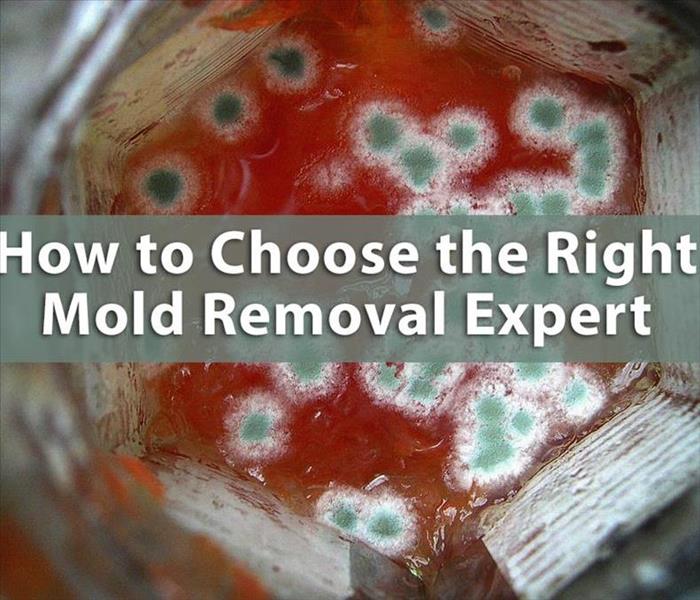 Mold is a service SERVPRO of Palm Desert Performs
Mold is a service SERVPRO of Palm Desert Performs
Choosing the right mold removal expert is a decision not to be made lightly. Since the mold can cause health effects, you want thee job is done right, you want to make sure you hire the right company.
Mold remediators are not created equal. Finding a qualified professional, who is trained in the treatment and removal of mold, can be difficult.
Here’s what to look for when hiring a mold removal expert.
Check for certification
Make sure that the mold remediation company you hire is certified, licensed and insured. Ask about their experiences and certifications to make sure they have received relevant training. Any contractor who is unwilling to share their certifications should set off as a warning bell.
Ask for referrals
Make sure that the expert you hire can provide you with at least 3 references – names and numbers of customers they’ve worked for in the past. Try to contact at least 2 of these customers to see if they are satisfied with the contractor’s services.
Ask questions
Don’t be afraid to ask questions to make sure you hire the right one. They should be willing to answer any questions you may have. If the contractor dismisses your questions or demeans your concerns, then you might want to look elsewhere.
- Do your workers wear protective gear?
- What type of mold inspection do you conduct?
- Do you contain the area properly?
Tips for Detecting Mold in your Home
12/9/2015 (Permalink)
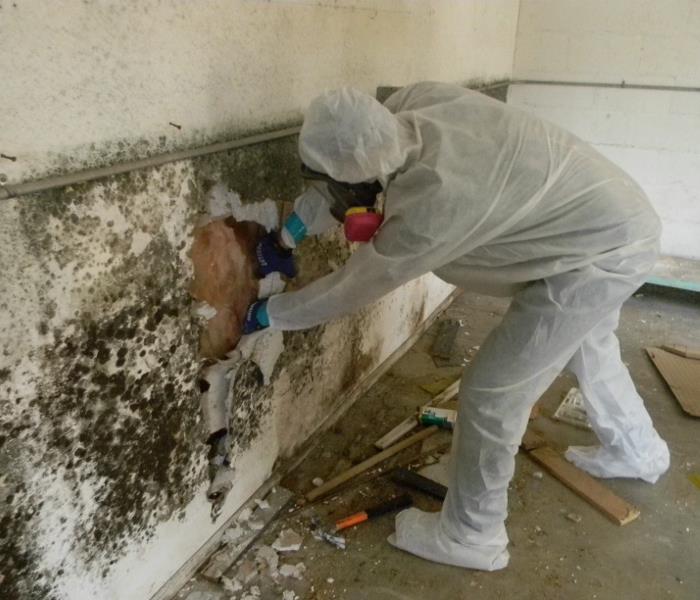 Mold Damage in Homes
Mold Damage in Homes
Mold can be found pretty much anywhere in the home—including wood, paper, carpet, foods and insulation. As long as moisture and oxygen are present, mold growth is possible
When left undetected, Mold can grow and leave damaging effects on a home. For something so potent, it would be helpful to know how to detect it as soon as possible.
SERVPRO of Palm Desert is happy to share a couple of tips that can help you uncover mold in your home.
1. Check certain areas such as Showers, Bathrooms, Kitchen, Roof Leaks, AC Leaks, and Discoloration on the Wall, Ceiling, and Cabinet area.
Many types of mold are visible with the naked eye, so always be on the lookout for discoloration on the walls, ceiling, and cabinets. Typical colors of mold include grey, white, green or black.
Hidden mold is more difficult and may be inside walls, insulation, or behind cabinets.
2. Use your sense of smell in your home.
Often times, homeowners have hidden molds and don’t realize it. However, if your house smells like a musty or mildew odor, it can be a good indicator of a hidden mold residing in your home.
3. Check humidity levels.
Mold is caused by the presence of too much moisture or water. Mold prefers dark moist places such as under the sinks and underneath showers. Typically, there is an excess of moisture when it’s cold. Because of this, it is important to keep humidity levels below 40 percent. At this level, mold growth is slowed down and can be prevented.
4. Check your home after a flood or suspected leak.
If your home has been exposed to flooding or leaks, there is a good chance that your home might have mold growth. After any flood or leak, be sure to search for possible signs of mold. It may be necessary to consult with a respected Industrial Hygienist- IAQ to perform an air quality test to better identify the kind of mold that may be present.
If for any reason you find mold growing in your home, please don’t hesitate to give SERVPRO of Palm Desert a call today. We are happy to take care of any and all mold remediation projects you may have. Prevention is the key to protecting your home. SERVPRO of Palm Desert is always here to help.





 24/7 Emergency Service
24/7 Emergency Service
